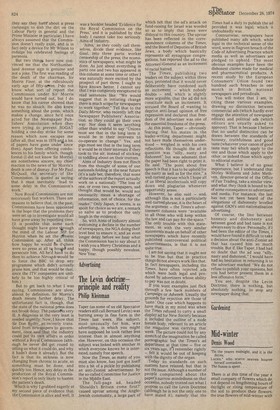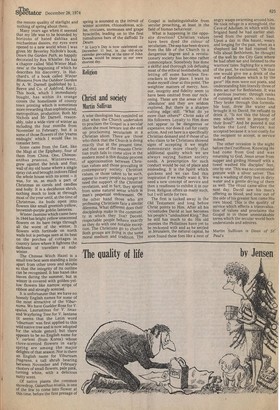Gardening
Mid-winter
Denis Wood
'Tis the yeares midnight, and it is the dayes,
Lucies,* who scarce seaven houres herself Unmaskes,
The Sunne is spent. . .
There is at this time of the year a small company of flowers which do not depend on lengthening hours of daylight or rising temperature of the soil to produce their flowers, the true flowers of mid-winter with the remote quality of starlight and nothing of spring about them.
Many years ago when it seemed that my life was to be bounded by horizons of hated dahlias and michaelmas daisies, my eyes were opened to a new world when I was given Mr Beverley Nichols's book, Down the Garden Path, so happily decorated by Rex Whistler. He has a chapter called 'Mid-Winter Madness' at the beginning of which he describes his discovery, in Hatchard's, of a book called Winter Blossoms from the Outdoor Garden by A. W. Darnell (published by L. Reeve and Co. of Ashford, Kent). This book, which I immediately bought, has within its orange covers the homeliness of county town printing which is sometimes more rewarding than sophisticated, metropolitan, production. Both Mr Nichols and Mr Darnell, reasonably, take a wide view of winter as including the four months from November to February, but it is some of those flowers of the 'yeares midnight' which I would like to consider here.
Some came from the East, like the Magi at the Epiphany, four of them from China. One, Chimonanthus praecox, Wintersweet, grew against the brick and flint wall of my old home where a single spray cut and brought indoors filled the whole house with its scent — it was, for us, as much a part of Christmas as carols and candles and holly. It is a deciduous shrub, nothing much to look at through most of the year until, at the time of Christmas, its buds open into flowers like small greenish-yellow, brownish-purple goblin lanterns. Winter Jasmine which came here in 1844 has bright yellow unscented flowers on its bare twigs through all the worst of the winter, It _ flowers with fortitude on north walls but is perhaps seen at its best on the porches of cottages in country lanes where it lightens the darkness of travellers at midwinter.
The Chinese Witch Hazel is a small tree best seen standing a little apart from other trees and shrubs so that the integrity of its outline can be recognised. It has hazel-like leaves during the summer, but in winter is covered with golden-yellow flowers like narrow strips of ribbon and strongly scented.
It is unfortunate that we have no homely English names for some of the most attractive of the Viburnums. We have Guelder Rose for V. opulus, Laurustinus for V. tinus and Wayfaring Tree for V. lantana (it seems that the Latin word 'viburnum' was first applied to this wild native tree and is now adopted for the whole genus), but there appears to be no English name for V. carlesii (from Korea) whose clove-scented flowers in early spring are among the major delights of that season. Nor is there an English name for Viburnum fragrans, a tall shrub bearing between November and February clusters of small flowers, pale pink, turning white, with a delicious nutty scent.
Of native plants the common snowdrop, Galanthus nivalis, is one of the few to come into flower at this time, before the first presage of spring is sounded in the introit of winter aconites, chionodoxas, scillas, crocuses, anemones and grape hyacinths, leading on to the first tumultuous bars of the daffodil Te Deum.
St Lucy's Day is now celebrated on December 11 but, in the old-style calendar prevailing at the time of John Donne, would be nearer to our own shortest day.















































 Previous page
Previous page